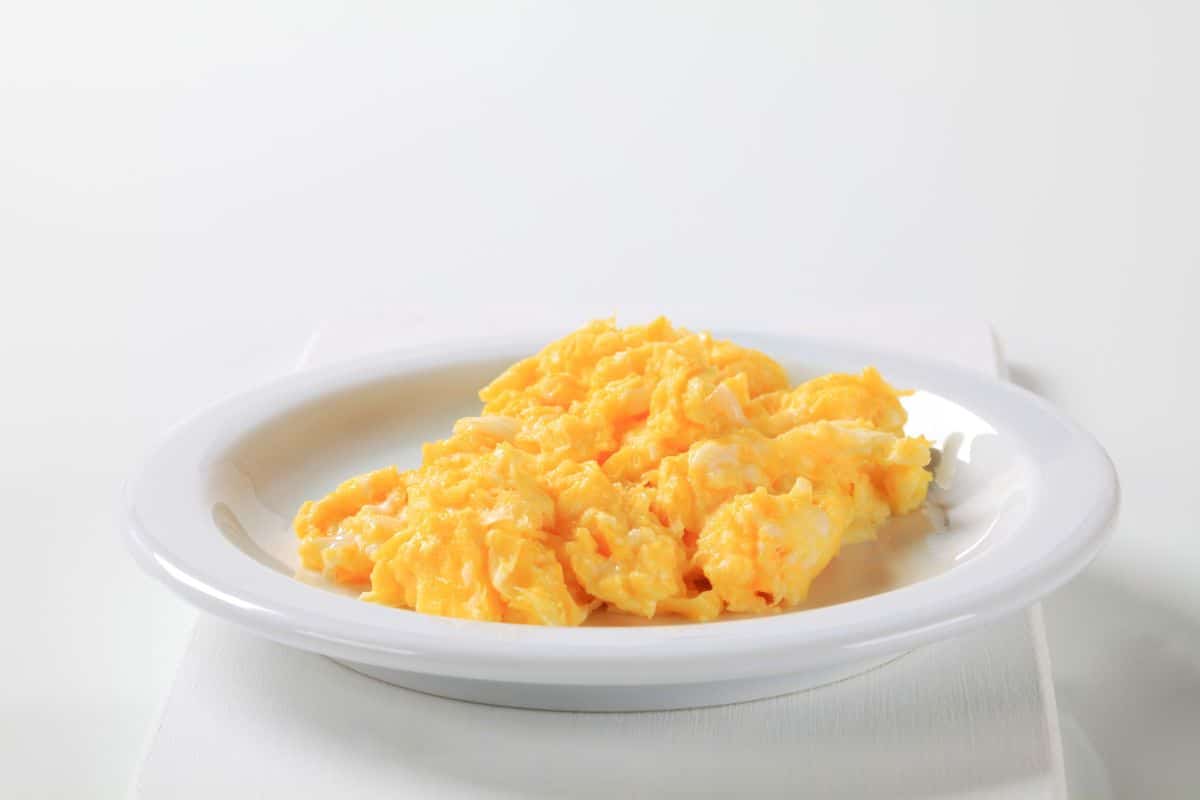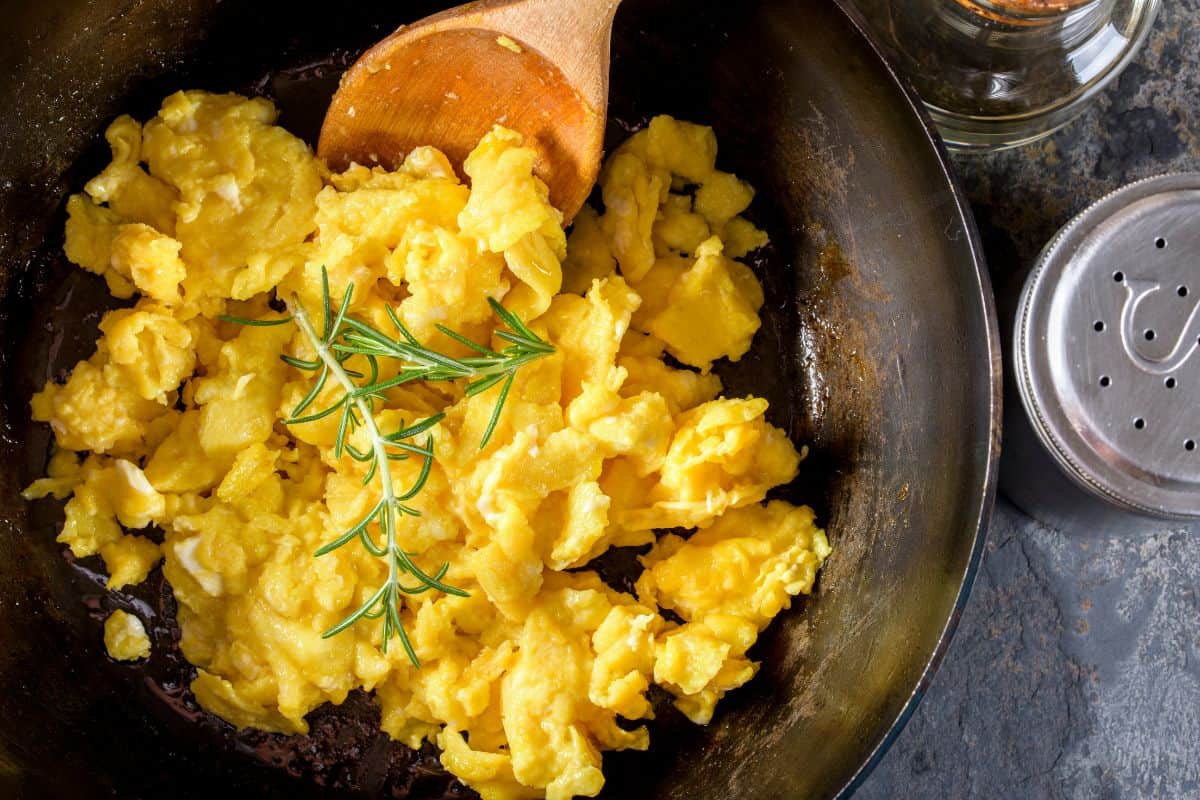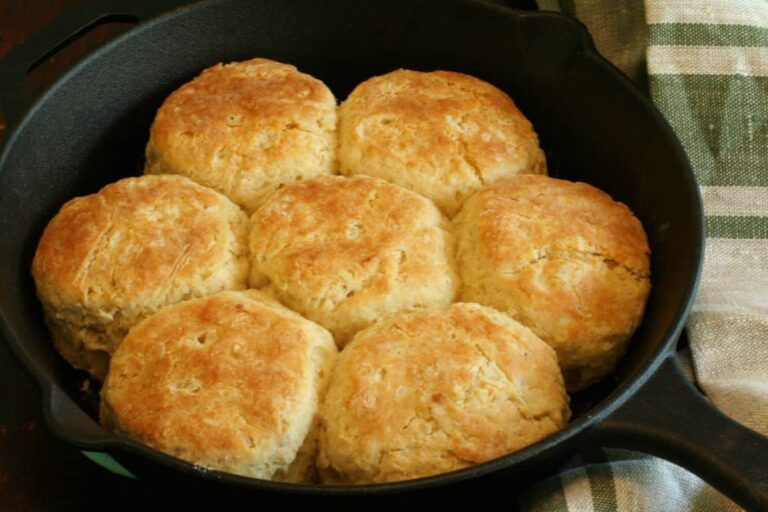The Right Way to Cook Scrambled Eggs in Cast Iron

Lots of people will tell you that you should never, ever cook scrambled eggs in cast iron. Why not, you may ask? They stick and make a big mess!
But what if I told you they don’t have to stick? I’m here to give you all the tips and tricks for light, fluffy scrambled eggs every time – and a sparkling clean pan you won’t need to scrub when you’re done.
(As an Amazon Associate I earn from qualifying purchases. This means that if you purchase an item via a link on my website I earn a small commission at no extra cost to you.)
Scrambled Eggs Basics
Have you ever had lifeless, rubbery scrambled eggs? I love eggs, and I will eat them no matter what terrible thing I might inadvertently do to them. That said, I definitely prefer a fluffy scrambled egg to a rubbery one.
Adding dairy like milk, cream, or even cottage cheese or yogurt, can give your eggs a softer texture. Personally, I like to add buttermilk.
Some people add water to eggs. The idea is that the water will convert to steam as the eggs cook and the eggs’ texture will be more open as a result. When I add water, my results aren’t any better so I don’t do it. However, there may be some trick I’m missing – so feel free to try!
One of my tricks for keeping my eggs fluffy is just to make sure I whip them a lot beforehand to get a lot of air into the mixture. Then, I don’t over-stir while cooking them. A lot of stirring can knock the air out and make them flat.
Instead, I let the eggs cook for a while before touching them (that’s part of my no-stick secret too, shhh), and then gently scrape the bottom of the pan with a thin metal spatula to slowly create large curds.
Cooking over lower heat will also help your eggs stay light and fluffy.
Choose the right Cast Iron Skillet

One essential thing when cooking eggs in cast iron is to choose the right cast iron skillet.
As with anything you cook in cast iron, it’s best to use a well-seasoned skillet. You can heap extra butter on your pan all day long; you’re still likely to have sticking issues if your pan isn’t well-seasoned.
That said, the texture of your cast iron itself also makes a difference. For example: my grandmother’s old cast iron pans are a smoother texture than my new ones. The ones I bought have a rough, pebbly texture.
While I have successfully cooked scrambled eggs on my newer pans, my results were inconsistent. When I use my grandmother’s cast iron, I can consistently guarantee my eggs won’t stick when I use this method.
If you’re looking for smoother skillets you can do one of two things. My first suggestion would be to hit one of your local thrift stores or antique shops. If it’s rusty, no problem. It’s very easy to restore cast iron.
Alternatively, You could purchase a modern polished cast iron skillet. Manufacturers polish the surface of these pans in order to create a smoother cooking surface. The three main companies I would recommend are Stargazer, Smithey, and the Field Company.
Use a well-seasoned pan
Traditional nonstick pans have toxic coatings that, while allowing you to cook oil-free without your food sticking, also have health risks associated with them. I highly recommend switching to a non-toxic cooking option!
Your cast iron skillet needs to be well-seasoned in order to prevent sticking with scrambled eggs. You can tell if your pan is well-seasoned if other food you’ve been cooking has been lifting away nicely, and also by looking at it. If you’re seeing lighter patches or even chipped away patches in your black finish, then it may be time to re-season.
Even if you have the most well-seasoned cast iron skillet in the nation, it isn’t perfectly non-stick on its own. You need to cook the food in oil. My favorite is butter, but you can also use other healthy oils like coconut or olive oil.
I recommend using a thin-edged metal spatula to help prevent sticking. I like to cook with my nice wooden spatula, but I’ve found that the thicker edge makes it harder to guarantee that my eggs won’t stick.
How to Cook Scrambled Eggs

- Preheat the pan. It’s essential to preheat any cast iron pan before cooking. Let it get hot before adding your fat and eggs.
- Mix thoroughly. Whisk the egg mixture a lot! This will help guarantee that the whites, yolk, and buttermilk are well incorporated. It also adds a lot of air into the egg mixture so your final result is fluffier. You can use an electric mixer if you wish. For this recipe, you’ll want to add your buttermilk and salt and pepper before whisking. (If you want to add cheese, do this after whisking and stir gently to incorporate.)
- Add fat to the pan. All cast iron pans need a fat in the pan to prevent sticking, even if you have the most well-seasoned pan in all of history. I add 1 tbsp of butter for six eggs, which is enough for my family of four. I let it cook in the pan until it becomes golden, which adds to the depth of flavor.
- Let eggs sit. Add your eggs to the pan and turn the heat down to low. Because cast iron retains its heat well, they’ll cook thoroughly. The most important thing here is to let your eggs sit for at least 30 seconds. Make sure a skin has formed all along the bottom of your eggs before you begin to stir.
- Stir SLOWLY. Stir gently with long strokes, scraping the bottom of the pan as you go. This will create large curds. Stirring too quickly might cause the eggs to stick. Stir only until they’re mostly set, but still a little wet, and remove from the heat. Stir a bit more until eggs are the desired texture.
- Serve. Remove the eggs from the pan immediately after cooking. Because cast iron retains heat so effectively, your eggs may turn dry and overcooked if you leave them in the pan.

Buttermilk Scrambled Eggs on Cast Iron
These tasty, fluffy scrambled eggs not only taste great, but they won't gum up your cast iron pan!
Ingredients
- 6 eggs
- 1/4 c. buttermilk
- Salt & Pepper to taste
- 1/4 shredded or cottage cheese (optional)
- 1 Tbsp of butter for pan
Instructions
- Preheat a 10-inch cast iron skillet over medium heat.
- Whisk eggs, buttermilk, and salt & pepper thoroughly until mixture has turned a lighter yellow and is full of bubbles.
- Add cheese to egg mixture if desired and stir gently until incorporated.
- Add butter to pan and spread it thoroughly with a metal spatula. Wait until it turns golden, then turn heat down to low and add the egg mixture.
- Let the eggs sit for at least 30 seconds before stirring. This will allow the eggs to cook partially which helps prevent sticking. Then, stir slowly with long strokes, dragging spatula across the bottom of the pan. This should form large curds. Stirring too quickly could cause eggs to stick.
- Remove pan from heat after eggs are set but still a little wet. Stir a little more until eggs are the desired texture, then serve immediately. Do not leave eggs on the pan, as they will continue cooking and could become dry and overcooked.
Nutrition Information:
Yield: 4Amount Per Serving: Calories: 165Total Fat: 12.3gSaturated Fat: 5.4gCholesterol: 294.4mgSodium: 189.3mgCarbohydrates: 1.5gFiber: 0gSugar: .8gProtein: 11.7g
I hope you enjoy cooking these delicious buttermilk scrambled eggs on your own cast iron skillet. Leave me a note in the comments or a rating to let me know how it goes!





